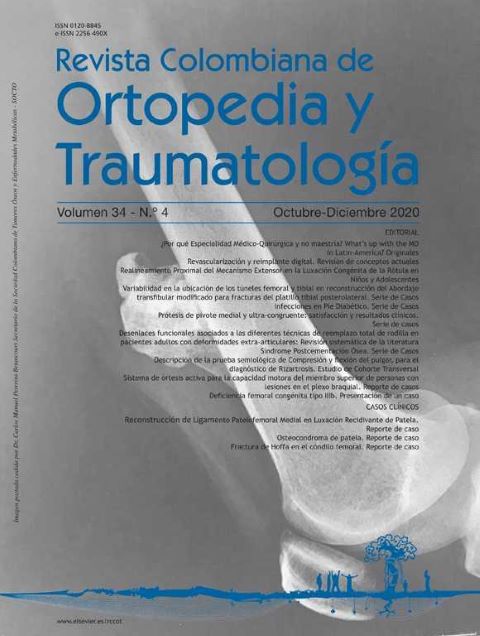Bone Cement Implantation Syndrome. Case Series
DOI:
https://doi.org/10.1016/j.rccot.2020.10.003Keywords:
bone cement implantation syndrome, femoral neck fracture, hemiarthroplasty, outcome, risk factorsAbstract
Background: The bone cement implantation syndrome (BCIS) is a frequent and potentially devastating intraoperative complication in patients undergoing cemented hip arthroplasty. The objective of study is to describe the frequency of BCIS in patients undergoing total or partial hip arthroplasty.
Methods: Case series study. We reviewed the medical records of adult patients over 50 years of age with an indication for Arthroplasty or Hemiatroplasty. The perioperative variables were analyzed through the Anesthesia registry. The degree of SICO was determined by Donaldson classification. Descriptive statistics and multiple correspondence analysis were used to explore the relationship between the variables.
Results: We included 49 patients with an average age of 78 years (SD +/- 9.9), 39 were women (79.6%) and 37 (75.5%) had an ASA II classification. We documented the presence of SICO in 8 patients (16.3%): of which 5 corresponded to Grade 1, 2 Grade 2 and 1 to Grade 3 with ICU requirement. 7 were women; all were hypertensive, 2 diabetes mellitus, 2 COPD and 1 osteoporosis. None reported Warfarin ingestion.
Discussion: BCIS is a frequent phenomenon in the arthroplasty and cemented hemiarthroplasty, being higher in the female sex, documenting the presence of predictors of severity ASA II -III classification and the history of COPD in our hospital.
Evidence Level: IV
Downloads
References
Learmonth ID, Young C, Rorabeck C. The operation of the century: total hip replacement. Lancet. 2007;370:1508-19. https://doi.org/10.1016/S0140-6736(07)60457-7
Kurtz S, Ong K, Lau E, Mowat F, Halpern M. Projections of primary and revision hip and knee arthroplasty in the United States from 2005 to 2030. J Bone Joint Surg Am. 2007;89:780-5. https://doi.org/10.2106/JBJS.F.00222
Costa ML, Griffin XL, Pendleton N, Pearson M, Parsons N. Does cementing the femoral component increase the risk of perioperative mortality for patients having replacement surgery for a fracture of the neck of femur? Data from the National Hip Fracture Database. J Bone Joint Surg Br. 2011;93:1405-10.
Griffiths R, White SM, Moppett IK, Parker MJ, Chesser TJ, Costa ML, et al. Safety guideline: reducing the risk from cemented hemiarthroplasty for hip fracture 2015: Association of Anaesthetists of Great Britain and Ireland British Orthopaedic Association British Geriatric Society. Anaesthesia. 2015;70:623-6. https://doi.org/10.1111/anae.13036
Olsen F, Kotyra M, Houltz E, Ricksten SE. Bone cement implantation syndrome in cemented hemiarthroplasty for femoral neck fracture: incidence, risk factors, and effect on outcome. Br J Anaesth. 2014;113:800-6.
Singh V, Bhakta P, Zietak E, Hussain A. Bone cementimplantation syndrome: a delayed postoperative presentation. J Clin Anesth. 2016;31:274-7.
Soleimanha M, Sedighinejad A, Haghighi M, Nabi BN, Mirbolook AR, Mardani-Kivi M. Hemodynamic and Arterial Blood Gas Parameters during Cemented Hip Hemiarthroplasty in Elderly Patients. Arch Bone Jt Surg. 2014;2:163-7.
Rothberg DL, Kubiak EN, Peters CL, Randall RL, Aoki SK. Reducing the risk of bone cement implantation syndrome during femoral arthroplasty. Orthopedics. 2013;36:e463-7. https://doi.org/10.3928/01477447-20130122-51
Urban MK, Sheppard R, Gordon MA, Urquhart BL. Right ventricular function during revision total hip arthroplasty. Anesth Analg. 1996;82:1225-9.
Segerstad MHA, Olsen F, Patel A, Houltz E, Nellgård B, Ricksten SE. Pulmonary haemodynamics and right ventricular function in cemented vs uncemented total hip arthroplasty-A randomized trial. Acta Anaesthesiol Scand. 2018.
Donaldson AJ, Thomson HE, Harper NJ, Kenny NW. Bone cement implantation syndrome. Br J Anaesth. 2009;102:12-22. https://doi.org/10.1093/bja/aen328
Parvizi J, Ereth MH, Lewallen DG. Thirty-day mortality following hip arthroplasty for acute fracture. J Bone Joint Surg Am. 2004;86-A:1983-8.
Timperley AJ, Whitehouse SL. Mitigating surgical risk in patients undergoing hip arthroplasty for fractures of the proximal femur. J Bone Joint Surg Br. 2009;91:851-4. https://doi.org/10.1302/0301-620X.91B7.22617
Koessler MJ, Fabiani R, Hamer H, Pitto RP. The clinical relevance of embolic events detected by transesophageal echocardiography during cemented total hip arthroplasty: a randomized clinical trial. Anesth Analg. 2001;92:49-55. https://doi.org/10.1097/00000539-200101000-00010
Byrick RJ. Cementimplantation syndrome: a time limited embolic phenomenon. Can J Anaesth. 1997;44:107-11. https://doi.org/10.1007/BF03012996
Ereth MH, Weber JG, Abel MD, Lennon RL, Lewallen DG, Ilstrup DM, et al. Cemented versus noncemented total hip arthroplasty-embolism, hemodynamics, and intrapulmonary shunting. Mayo Clin Proc. 1992;67:1066-74. https://doi.org/10.1515/ijsl.1992.93.67
Bisignani G, Bisignani M, Pasquale GS, Greco F. Intraoperative embolism and hip arthroplasty: intraoperative transesophageal echocardiographic study. J Cardiovasc Med (Hagerstown). 2008;9:277-81.
Park HJ, Kang H, Lee JW, Baek SM, Seo JS. Comparison of hemodynamic changes between old and very old patients undergoing cemented bipolar hemiarthroplasty under spinal anesthesia. Korean J Anesthesiol. 2015;68:37-42. https://doi.org/10.4097/kjae.2015.68.1.37





